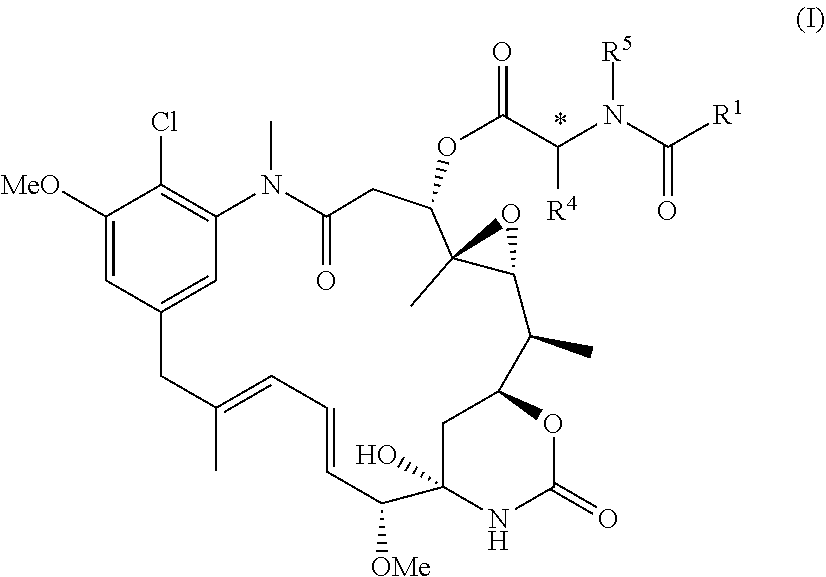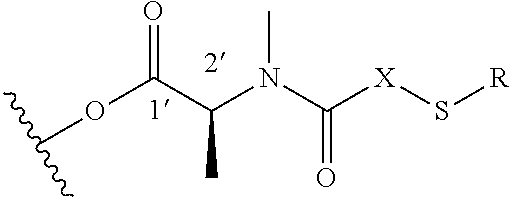Diasteroselective process for the preparation of thiol- or disulfide-containing maytansinoid esters and intermediates thereof
- Summary
- Abstract
- Description
- Claims
- Application Information
AI Technical Summary
Problems solved by technology
Method used
Image
Examples
example 1
Preparation of 3-O-(2′S-azidopropionyl)-maytansinol
[0105]
[0106]In a round bottom flask, dicyclohexylcarbodiimide DCC (2700 mg, 13 mmol) in dry dichloromethane CH2Cl2 (5 mL) and 1.9 M ZnCl2 in 2-Me-THF (0.76 mL, 1.44 mmol) were added dropwise to a solution of maytansinol (680 mg, 1.20 mmol) and 2-(S)-azido propionic acid (1350 mg, 12 mmol) in dry dichloromethane (15 mL). After overnight stirring, the reaction mixture was diluted with ethyl acetate (AcOEt) and filtered. The obtained clear solution was washed with saturated NaHCO3 and brine. The organic phase collected was dried over sodium sulphate Na2SO4 and the solvent was removed under vacuum. Purification of the crude product by silica gel chromatography (MeOH:CH2Cl2 98:2) yielded 3-O-(2′S-azidopropionyl)-maytansinol as a white solid (370 mg, 0.56 mmol, Y=66%, considering the residual 15% of maytansinol).
[0107]1H-NMR (400 MHz, CDCl3) δ 7.10 (s, 1H), 6.82 (s, 1H), 6.42 (dd, J=15.3, 11.1 Hz, 1H), 6.33 (s, 1H), 6.19 (d, J=10.8 Hz, 1H...
example 2
Preparation of N-methyl-L-alanine maytansinol ester
[0110]
[0111]In a round bottom flask, 3-O-(2′S-azidopropionyl)-maytansinol (30 mg, 0.04 mmol) in dry dichloromethane (1 mL) was treated with triphenylphosphine PPh3 (25 mg, 0.09 mmol). After overnight stirring, paraformaldehyde (7 mg, 0.23 mmol) was added and the mixture was stirred until complete conversion of the starting material (monitored by TLC), then it was cooled to 0° C. and treated with methanol (MeOH, 0.5 mL) and NaBH4 (9 mg, 0.24 mmol). At the completion of the reduction, the reaction was quenched with saturated NaHCO3 and diluted with dichloromethane (CH2Cl2). The organic phase was collected and washed with saturated NaHCO3 and brine, dried over sodium sulfate and evaporated under reduce pressure. Purification of the crude product by silica gel chromatography (linear gradient 0-10% MeOH:CH2Cl2) afforded N-methyl-L-alanine maytansinol ester (7 mg, 0.01 mmol, Y=27%) and L-alanine maytansinol ester (17 mg, 0.03 mmol, Y=67%)...
example 3
Staudinger reduction of 3-O-(2′S-azidopropionyl)-maytansinol
[0115]
[0116]In a round bottom flask, 3-O-(2′S-azidopropionyl)-maytansinol (28 mg, 0.04 mmol) in THF (1 mL) was treated with triphenylphosphine (PPh3, 20 mg, 0.08 mmol) in the presence of water (0.03 mL). The mixture was stirred for about 24-48 h, then evaporated under reduce pressure. Purification of the crude product by silica gel chromatography (1:9 MeOH:CH2Cl2) yielded L-alanine maytansinol ester (20 mg,0.03 mmol, Y=87%).
[0117]1H-NMIR (400 MHz, CDCl3) δ 6.83 (s, 1H), 6.79 (s, 1H), 6.40 (dd, J=18.4, 7.9 Hz, 2H), 6.16 (d, J=10.9 Hz, 1H), 5.52 (dd, J=15.4, 8.9 Hz, 1H), 4.92 (dd, J=11.9, 3.0 Hz, 1H), 4.28 (t, J=11.1 Hz, 1H), 3.97 (s, 3H), 3.66 (m, 1H), 3.54-3.41 (m, 4H), 3.32 (s, 3H), 3.14 (s, 3H), 2.86 (d, J=9.6 Hz, 1H), 2.57 (dd, J=14.0, 12.1 Hz, 1H), 2.21 (dd, J=14.1, 2.9 Hz, 1H), 1.65 (s, 3H), 1.46 (d, J=6.8 Hz, 3H), 1.26 (d, J=6.3 Hz, 3H), 0.83 (s, 3H).
PUM
 Login to view more
Login to view more Abstract
Description
Claims
Application Information
 Login to view more
Login to view more - R&D Engineer
- R&D Manager
- IP Professional
- Industry Leading Data Capabilities
- Powerful AI technology
- Patent DNA Extraction
Browse by: Latest US Patents, China's latest patents, Technical Efficacy Thesaurus, Application Domain, Technology Topic.
© 2024 PatSnap. All rights reserved.Legal|Privacy policy|Modern Slavery Act Transparency Statement|Sitemap



